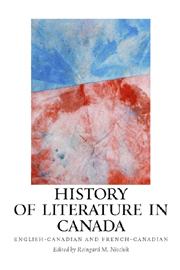Book contents
- Frontmatter
- Contents
- Acknowledgments
- Introduction: Writing a History of Literature in Canada
- I Beginnings
- II The Literature of New France, 1604–1760
- III The Literature of British Canada, 1763–1867
- IV From the Dominion to the Territorial Completion of the Nation, 1867–1918
- V The Modern Period, 1918–1967
- VI Literature from 1967 to the Present
- 21 Sociopolitical and Cultural Developments from 1967 to the Present
- 22 English-Canadian Literary Theory and Literary Criticism
- 23 The English-Canadian Novel from Modernism to Postmodernism
- 24 The English-Canadian Short Story since 1967: Between (Post)Modernism and (Neo)Realism
- 25 English-Canadian Poetry from 1967 to the Present
- 26 Contemporary English-Canadian Drama and Theater
- 27 Canons of Diversity in Contemporary English-Canadian Literature
- 28 Literature of the First Nations, Inuit, and Métis
- 29 The Quebec Novel
- 30 The French-Canadian Short Prose Narrative
- 31 French-Canadian Poetry from 1967 to the Present
- 32 Orality and the French-Canadian Chanson
- 33 Drama and Theater from the Révolution tranquille to the Present
- 34 Transculturalism and écritures migrantes
- 35 The Institutionalization of Literature in Quebec
- Further Reading
- Notes on the Contributors
- Index
27 - Canons of Diversity in Contemporary English-Canadian Literature
from VI - Literature from 1967 to the Present
Published online by Cambridge University Press: 12 September 2012
- Frontmatter
- Contents
- Acknowledgments
- Introduction: Writing a History of Literature in Canada
- I Beginnings
- II The Literature of New France, 1604–1760
- III The Literature of British Canada, 1763–1867
- IV From the Dominion to the Territorial Completion of the Nation, 1867–1918
- V The Modern Period, 1918–1967
- VI Literature from 1967 to the Present
- 21 Sociopolitical and Cultural Developments from 1967 to the Present
- 22 English-Canadian Literary Theory and Literary Criticism
- 23 The English-Canadian Novel from Modernism to Postmodernism
- 24 The English-Canadian Short Story since 1967: Between (Post)Modernism and (Neo)Realism
- 25 English-Canadian Poetry from 1967 to the Present
- 26 Contemporary English-Canadian Drama and Theater
- 27 Canons of Diversity in Contemporary English-Canadian Literature
- 28 Literature of the First Nations, Inuit, and Métis
- 29 The Quebec Novel
- 30 The French-Canadian Short Prose Narrative
- 31 French-Canadian Poetry from 1967 to the Present
- 32 Orality and the French-Canadian Chanson
- 33 Drama and Theater from the Révolution tranquille to the Present
- 34 Transculturalism and écritures migrantes
- 35 The Institutionalization of Literature in Quebec
- Further Reading
- Notes on the Contributors
- Index
Summary
The Politics of Multiculturalism
BOTH IN THEORY AND IDEALLY also in practice, Canada has adopted a constitutional policy of multiculturalism that comprises the layered, interrelated histories and cultures of all its constituent groups: English Canadians, French Canadians, First Nations, and other ethnic minorities alike. Before the passing of the 1947 Canadian Citizenship Act, all Canadians were counted as British subjects, but over the following two decades, mounting local and international tensions — such as Quebec nationalism, growing demands for compensation from members of the First Nations, and post-Second World War immigration policies — required a revision of the Canadian concept of nation. Canadian identity was thus detached from a community ideal as being homogeneously White (or more precisely, of Anglo-Saxon ethnicity and religion), reflecting the heterogeneous makeup of its changing population. Beyond its significant indigenous population now numbering about one million people, and its settlement by originally two groups, the English and the French, Canada has been an immigrant-receiving country since the early nineteenth century. Whereas Canada brought a relatively small number of Jews to safety during the Nazi regime, the country — as a deliberate atonement for earlier mistakes such as the repression of the Japanese during the Second World War and the Chinese Exclusion Act of 1923 — opened its doors in the early 1950s to hitherto less-preferred immigrant groups, welcoming since 1990 as many as 200,000 immigrants annually. Today, more than one hundred different minority ethnic groups live in Canada, and the foreign-born alone account for about nineteen percent of the overall population.
- Type
- Chapter
- Information
- History of Literature in CanadaEnglish-Canadian and French-Canadian, pp. 387 - 412Publisher: Boydell & BrewerPrint publication year: 2008



